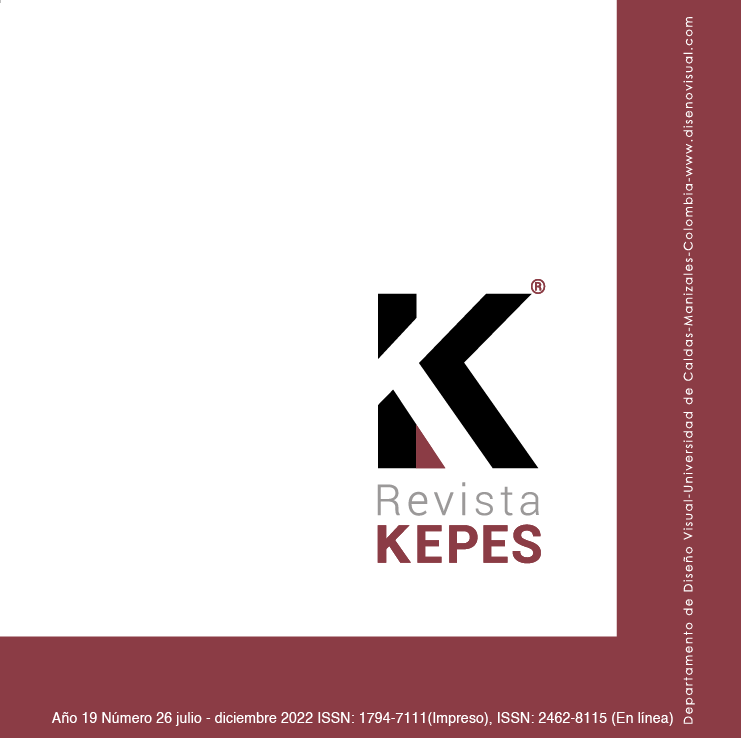Authors
Abstract
The possibilities of the timeline as a tool for creating collective stories through co-design processes is analyzed in this paper. Visualization research and its narrative dimension give priority to the role of experts who define experiences. However, not as is paid to alternatives based on participation that allow amplifying the voices in the narrative construction. Based on a critical review of visualization and timelines, a series of criteria -modality, plurality,
simultaneity, non-linearity and inclusiveness- is proposed as the basis for an analysis model applied in two research actions in co-design with communities. The results show that the format is relevant in inclusive processes of creation and discussion due to its simplicity and clarity, since it favors the addition of factors and points of view around significant stories for a group.
References
Aiello, G. (2020). Inventorizing, situating, transforming: Social semiotics and data visualization. En M. Engebretsen y H. Kennedy (Eds.), Data Visualization in Society (pp. 49-62). Amsterdam University Press.
Brehmer, M., Lee, B., Bach, B., Riche, H. & Munzner, T. (2016). Timelines revisited: A design space and considerations for expressive storytelling. IEEE transactions on visualization and computer graphics, 23(9), 2151-2164. https://doi.org/10.1109/tvcg.2016.2614803
Brockmeier, J. (2000). Autobiographical time. Narrative inquiry, 10(1), 51-73. https://doi.org/10.1075/ni.10.1.03bro
Carr, D. (1991). Time, narrative, and history. Indiana University Press.
Carter, S., Cox, A. & Bostock, M. (2013). Dissecting a Trailer: The Parts of the Film That Make the Cut. https://nyti.ms/3QcuzjZ
Cunliffe, A. L., Luhman, J. T. & Boje, D. M. (2004). Narrative temporality: Implications for organizational research. Organization Studies, 25(2), 261-286. https://doi.org/10.1177/0170840604040038
Dykes, B. (2016). Data storytelling: The essential data science skill everyone needs. Forbes. https://bit.ly/3BY2t7I
Daniels, M. (2017). How music taste evolved. https://pudding.cool/2017/03/music-history/index.html
Di Bartolomeo, S., Pandey, A., Leventidis, A., Saffo, D., Syed, U. H., Carstensdottir, E., Seif el-Nasr, M., Borkin, M. A. & Dunne, C. (2020, February 4). Evaluating the Effect of Timeline Shape on Visualization Task Performance. Proceedings of the 2020 CHI Conference on Human Factors in Computing Systems (pp. 1- 12). https://doi.org/10.1145/3313831.3376237
Dunne, A. & Raby, F. (2013). Speculative everything: design, fiction, and social dreaming. MIT Press.
El Zowalaty, M. E. & Järhult, J. D. (2020). From SARS to Covid-19: A previously unknown SARSCoV-2 virus of pandemic potential infecting humans–Call for a One Health approach. One
Health, 9, 100124. https://doi.org/10.1016/j.onehlt.2020.100124
Fuentes, C. (1991). Algunas reflexiones sobre el concepto de modalidad. Revista española de lingüística aplicada, 7, 93-108.
Genette, G. (1970). Fronteras del relato. En R. Barthes y otros, Análisis estructural del relato (pp. 193-208). Editorial Tiempo Contemporáneo.
Jaszczolt, K. M. & Jaszczolt, K. (2009). Representing time: An essay on temporality as modality. Oxford University Press.
Kim, N. W., Bach, B., Im, H., Schriber, S., Gross, M. & Pfister, H. (2017). Visualizing nonlinear narratives with story curves. IEEE transactions on visualization and computer graphics, 24(1), 595-604. https://doi.org/10.1109/tvcg.2017.2744118
Lee, B., Riche, N. H., Isenberg, P. & Carpendale, S. (2015). More than telling a story: Transforming data into visually shared stories. IEEE computer graphics and applications, 35(5), 84-90. https://doi.org/10.1109/mcg.2015.99
Lloyd, D. (2010). Evaluating human-centered approaches to geovisualization. City University London.
Manzini, E. (2015). Cuando todos diseñan: Una introducción al diseño para la innovación social. Experimenta Editorial.
McCosker, A. & Wilken, R. (2014). Rethinking ‘big data’ as visual knowledge: the sublime and the diagrammatic in data visualisation. Visual Studies, 29(2), 155-164. https://doi.org/10.1080/1472586X.2014.887268
Riche, N. H., Hurter, C., Diakopoulos, N. y Carpendale, S. (Eds.). (2018). Data-driven storytelling. CRC Press.
Ricoeur, P. (2004). Tiempo y narración: la triple mimesis. En Tiempo y Narración I: configuración del tiempo en relato histórico (pp. 113-168). Siglo XXI editores.
Rettberg, J. W. (2020). Ways of knowing with data visualizations. En M. Engebretsen y H. Kennedy (Eds.), Data Visualization in Society (pp. 35-48). Amsterdam University Press.
Sánchez-Bonvehí, C. y Ribera, M. (2014). Visualización de la información en la democratización de los datos: propuestas desde el periodismo y la narratividad. El profesional de la información, 23(3), 311-318. https://doi.org/10.3145/epi.2014.may.11
Sanders, E. B.-N. & Stappers, P. J. (2008). Co-creation and the new landscapes of design. CoDesign, 1(4), 5-18. https://doi.org/10.5040/9781474282932.0011
Sanders, L. (2008). An evolving map of design practice and design research. Interactions, 15(6), 13-17. https://doi.org/10.1145/1409040.1409043
Stauber, M. (2015) Histography (website). https://histography.io/
Segel, E. y Heer, J. (2010). Narrative visualization: Telling stories with data. IEEE transactions on visualization and computer graphics, 16(6), 1139-1148. https://doi.org/10.1109/tvcg.2010.179
Seybold, P. (2006). Outside innovation: how your customers will co-design your company's future. Harper Collins.
Sterling, B. (2012). Foreword. En N. Shedroff & C. Noessel, Make it So: Interaction Design Lessons from Science Fiction (pp. xxvii-xx). Rosenfeld Media, Inc.
Tal, A. y Wansink, B. (2016). Blinded with science: Trivial graphs and formulas increase ad persuasiveness and belief in product efficacy. Public Understanding of Science, 25(1), 117-125. https://doi.org/10.1177/0963662514549688
Tong, C., Roberts, R., Borgo, R., Walton, S., Laramee, R. S., Wegba, K., ... y Ma, X. (2018). Storytelling and visualization: An extended survey. Information, 9(3), 65.
Van Leeuwen, T. (2005). Introducing social semiotics. Routledge.
Von Hippel, E. (2005). Democratizing innovation. MIT Press.
Weber, W. (2020). Exploring narrativity in data visualization in journalism. En M. Engebretsen y H. Kennedy (Eds.), Data Visualization in Society (pp. 295-311). Amsterdam University Press.

 PDF (Español)
PDF (Español)
 FLIP
FLIP






















